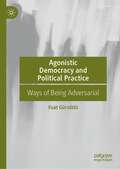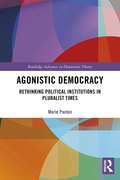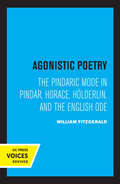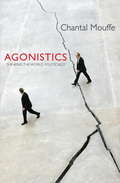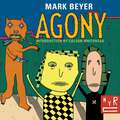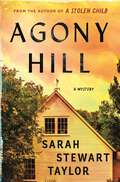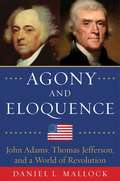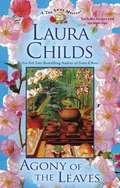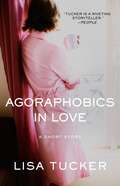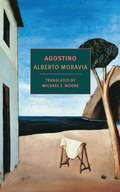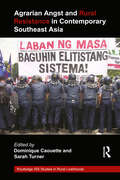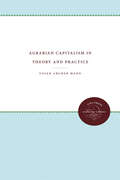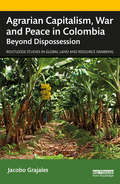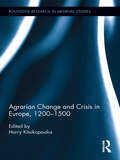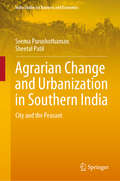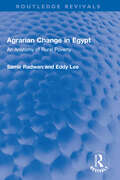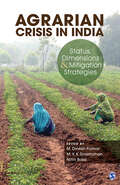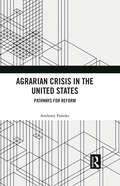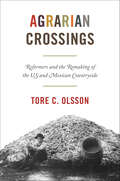- Table View
- List View
Agonistic Democracy and Political Practice: Ways of Being Adversarial
by Fuat GürsözlüThis book explores the implications of agonistic democratic theory for political practice. Fuat Gürsözlü argues that at a time when political parties exacerbate political division, political protesters are characterized as looters and terrorists, and extreme partisanship and authoritarian tendencies are on the rise, the agonistic approach offers a much-needed rethinking of political practice to critically understand challenges to democracy and envision more democratic, inclusive, and peaceful alternatives. Inspired by Chantal Mouffe’s agonistic theory and drawing on insights of other prominent agonistic scholars, Gürsözlü offers a distinctive approach that develops the connections between the agonistic approach and political practice. His main claim is that approaching democratic politics from an agonistic perspective changes the way we understand the nature of democratic society, the place of political protest in democracy, the nature of adversarial engagement, and the democratic function of political parties. The book also advances an account of agonistic peace that is best fitted to the pluralistic and inherently conflictual nature of democratic societies. This book should be of interest to anyone working in the field of contemporary political theory, political philosophy, peace studies, and philosophy of peace.
Agonistic Democracy: Rethinking Political Institutions in Pluralist Times (Routledge Advances in Democratic Theory)
by Marie PaxtonAgonistic Democracy explores how theoretical concepts from agonistic democracy can inform institutional design in order to mediate conflict in multicultural, pluralist societies. Drawing on the work of Foucault, Nietzsche, Schmitt, and Arendt, Marie Paxton outlines the importance of their themes of public contestation, contingency and necessary interdependency for contemporary agonistic thinkers. Paxton delineates three distinct approaches to agonistic democracy: David Owen’s perfectionist agonism, Mouffe’s adversarial agonism, and William Connolly and James Tully’s inclusive agonism. Paxton demonstrates how each is fundamental to enabling citizens to cultivate better virtues for themselves and society (Owen), motivating democratic engagement (Mouffe) and enhancing relations of respect and understanding between conflicting citizens (Connolly and Tully). Situated within the context of a deeply polarised post-Trump America and post-Brexit Britain, this book reveals the need to rethink our approach to conflict mediation through democratic institutions. Pulling together insights from experimental research with deliberative democratic innovations, Paxton explores how agonistic theory might be institutionalised further. Through discussing ways in which agonistic institutions might be developed to render democracy more virtuous, more engaging, and more inclusive, Agonistic Democracy provides a unique resource for students of contemporary political theory.
Agonistic Memory and the Legacy of 20th Century Wars in Europe (Palgrave Macmillan Memory Studies)
by Stefan Berger Wulf KansteinerThis book discusses the merits of the theory of agonistic memory in relation to the memory of war. After explaining the theory in detail it provides two case studies, one on war museums in contemporary Europe and one on mass graves exhumations, which both focus on analyzing to what extent these memory sites produce different regimes of memory. Furthermore, the book provides insights into the making of an agonistic exhibition at the Ruhr Museum in Essen, Germany. It also analyses audience reaction to a theatre play scripted and performed by the Spanish theatre company Micomicion that was supposed to put agonism on stage. There is also an analysis of a Massive Open Online Course (MOOC) designed and delivered on the theory of agonistic memory and its impact on the memory of war. Finally, the book provides a personal review of the history, problems and accomplishments of the theory of agonistic memory by the two editors of the volume.
Agonistic Poetry: The Pindaric Mode in Pindar, Horace, Hölderlin, and the English Ode
by William FitzgeraldThis title is part of UC Press’s Voices Revived program, which commemorates University of California Press’s mission to seek out and cultivate the brightest minds and give them voice, reach, and impact. Drawing on a backlist dating to 1893, Voices Revived makes high-quality, peer-reviewed scholarship accessible once again using print-on-demand technology. This title was originally published in 1993.
Agonistics
by Chantal MouffePolitical conflict in our society is inevitable, and its results are often far from negative. How then should we deal with the intractable differences arising from complex modern culture? Developing her groundbreaking political philosophy of agonistics - the search for a radical and plural democracy - Chantal Mouffe examines international relations, strategies for radical politics, the future of Europe and the politics of artistic practices. She shows that in many circumstances where no alternatives seem possible, agonistics offers a new road map for change. Engaging with cosmopolitanism, post-operaism, and theories of multiple modernities she argues in favour of a multipolar world with real cultural and political pluralism.From the Trade Paperback edition.
Agony
by Mark BeyerENJOY THE ECSTASY OF AGONY. Amy and Jordan are just like us: hoping for the best, even when things go from bad to worse. They are menaced by bears, beheaded by ghosts, and hunted by the cops, but still they struggle on, bickering and reconciling, scraping together the rent and trying to find a decent movie. It&’s the perfect solace for anxious modern minds, courtesy of one of the great innovators of American comics. Now if only Amy&’s skin would grow back ...This NYRC edition features a recreation of the original, pocket-size, slipcovered, paperback, designed by Art Spiegelman and Francoise Mouly.
Agony Hill: A Mystery (A Bethany, Vermont Mystery #1)
by Sarah Stewart TaylorSet in rural Vermont in the volatile 1960s, Agony Hill is the first novel in a new historical series full of vivid New England atmosphere and the deeply drawn characters that are Sarah Stewart Taylor's trademark.In the hot summer of 1965, Bostonian Franklin Warren arrives in Bethany, Vermont, to take a position as a detective with the state police. Warren's new home is on the verge of monumental change; the interstates under construction will bring new people, new opportunities, and new problems to Vermont, and the Cold War and protests against the war in Vietnam have finally reached the dirt roads and rolling pastures of Bethany. Warren has barely unpacked when he's called up to a remote farm on Agony Hill. Former New Yorker and Back-to-the-Lander Hugh Weber seems to have set fire to his barn and himself, with the door barred from the inside, but things aren’t adding up for Warren. The people of Bethany—from Weber’s enigmatic wife to Warren's neighbor, widow and amateur detective Alice Bellows — clearly have secrets they’d like to keep, but Warren can’t tell if the truth about Weber’s death is one of them. As he gets to know his new home and grapples with the tragedy that brought him there, Warren is drawn to the people and traditions of small town Vermont, even as he finds darkness amidst the beauty.
Agony and Eloquence: John Adams, Thomas Jefferson, and a World of Revolution
by Daniel Mallock<P>The drama of John Adams and Thomas Jefferson is the foundational story of America--courage, loyalty, hope, fanaticism, greatness, failure, forgiveness, love. <P> Agony and Eloquence is the story of the greatest friendship in American history and the revolutionary times in which it was made, ruined, and finally renewed. <P> In the wake of Washington’s retirement, longtime friends Thomas Jefferson and John Adams came to represent the opposing political forces struggling to shape America’s future. Adams’s victory in the presidential election of 1796 brought Jefferson into his administration--but as an unlikely and deeply conflicted vice president. <P>The bloody Republican revolution in France finally brought their political differences to a bitter pitch. In Mallock’s take on this fascinating period, French foreign policy and revolutionary developments--from the fall of the Bastille to the fall of the Jacobins and the rise of Napoleon--form a disturbing and illuminating counterpoint to events, controversies, individuals, and relationships in Philadelphia and Washington. <P>Many important and fascinating people appear in the book, including Thomas Paine, Camille Desmoulins, Dr. Benjamin Rush, Tobias Lear, Talleyrand, Robespierre, Danton, Saint-Just, Abigail Adams, Lafayette, James Madison, John Quincy Adams, Dr. Joseph Priestley, Samuel Adams, Philip Mazzei, John Marshall, Alexander Hamilton, and Edward Coles. They are brought to life by Mallock’s insightful analysis and clear and lively writing. <P>Agony and Eloquence is a thoroughly researched and tautly written modern history. When the most important thing is at stake, almost anything can be justified. <P><b>A New York Times Bestseller</b>
Agony of the Leaves
by Laura ChildsIn the latest novel from the New York Times bestselling author of Scones and Bones, Indigo Tea Shop owner Theodosia Browning finds herself in hot water when a body surfaces at the grand opening of Charleston's Neptune Aquarium... The opening of the aquarium is a major Charleston event, and Theodosia has been hired to cater tea, scones, and sandwiches for the private party to honor dignitaries and big buck donors. Things are going swimmingly, until Theodosia escapes the party for a momentary rest, only to discover the body of a man entangled in a net, drowned in one of the aquarium's state-of-the-art tanks.To make matters worse, the victim is Theodosia's former boyfriend Parker Scully. The EMTs on the scene think Parker's drowning was an accident, but when Theodosia notices what look like defense wounds on his hands, she realizes that someone wanted Parker dead. The local police aren't keen on hearing her theory-especially because of her ties to the victim-so Theodosia knows that if she wants Parker's killer brought to justice, she'll have to jump into the deep end and start her own investigation...INCLUDES DELICIOUS RECIPES AND TEA TIME TIPS!
Agora (A)
by Tom Quinn Thomas R. Eisenmann Lindsay N. HydeAgora was a civic technology (civic tech) startup founded by Elsa Sze, who wanted to enhance the connection between political officials and their constituents by facilitating virtual "town halls," making underrepresented voices heard and benefiting elected and appointed leaders who often struggled to collect meaningful feedback. Despite success in startup accelerator programs, challenges and complexities with government sales cycles led Sze to pivot the company multiple times, until she was selling customer service software to corporations and pondering whether she still wanted to build and sell Agora. A short financial runway meant she had to quickly decide where to invest her energy.
Agora (B)
by Tom Quinn Thomas R. Eisenmann Lindsay N. HydeThis is the conclusion to Agora (A), where founder Elsa Sze decides if she wants to continue investing energy in her civic technology startup. Agora was a civic technology (civic tech) startup founded by Elsa Sze, who wanted to enhance the connection between political officials and their constituents by facilitating virtual "town halls," making underrepresented voices heard and benefiting elected and appointed leaders who often struggled to collect meaningful feedback. Despite success in startup accelerator programs, challenges and complexities with government sales cycles led Sze to pivot the company multiple times, until she was selling customer service software to corporations and pondering whether she still wanted to build and sell Agora. A short financial runway meant she had to quickly decide where to invest her energy.
Agorafabulous!: Dispatches from My Bedroom
by Sara Benincasa“Sara Benincasa is one of the funniest writers I know—and I know a disturbing number of them. She is also one of the most honest.”—Sam Apple, author of American Parent and editor-in-chief of The Faster Times “Sara is extremely funny and should have many books out so we can all read them and laugh.” —Margaret ChoComedian, writer, blogger, radio and podcast host, and YouTube sensation, Sara Benincasa bravely and outrageously brings us “Dispatches from My Bedroom” with Agorafabulous! One of the funniest and most poignant books ever written about a mental illness, Agorafabulous! is a hilarious, raw, and unforgettable account of how a terrified young woman, literally trapped by her own imagination, evolved into a (relatively) high-functioning professional smartass. Down to earth and seriously funny, Benincasa’s no-holds-barred revelations offer readers the politically incorrect hilarity they heartily crave, yet is so often missing from your typical, weepy, and redemptive personal memoir.
Agoraphobia in the Light of Ego Psychology
by Edoardo WeissThe author explains agoraphobia in terms of an ego psychological perspective. In order to make his points clearer to the reader, the book is replete with references to his own patients. Wess also wrote an Appendix describing the history and the key concepts in ego psychology. Finally, throughout this work, he mentions the ideas of other psychoanalysts such as Sigmund Freud and some post-Freudian psychoanalysts.
Agoraphobics in Love
by Lisa TuckerAfter the accidental death of her parents, Emily retreated to their home, where she freelances for an online greeting card company and tries to come up with words for feelings she can no longer feel. Jules climbed his way up to creative director of an advertising agency; he had power, a girlfriend, and a great apartment in New York, when he started having the panic attacks that would leave him in a tiny sublet, unemployed and alone. But when Emily and Jules both join an online board for agoraphobics, what begins as friendship quickly develops into something much more. Now if only they can find the courage to leave their "safety zones" and actually meet for the first time...Witty, wistful, and deeply moving, "Agoraphobics in Love" is an O. Henry story for the twenty-first century. In sparkling prose, Lisa Tucker perfectly captures the miracle of two lonely people finding each other--and finding their way back to life.
Agostino
by Alberto Moravia Michael F. MooreThirteen-year-old Agostino is spending the summer at a Tuscan seaside resort with his beautiful widowed mother. When she takes up with a cocksure new companion, Agostino, feeling ignored and unloved, begins hanging around with a group of local young toughs. Though repelled by their squalor and brutality, and repeatedly humiliated for his weakness and ignorance when it comes to women and sex, the boy is increasingly, masochistically drawn to the gang and its rough games. He finds himself unable to make sense of his troubled feelings. Hoping to be full of manly calm, he is instead beset by guilty curiosity and an urgent desire to sever, at any cost, the thread of troubled sensuality that binds him to his mother. Alberto Moravia's classic, startling portrait of innocence lost was written in 1942 but rejected by Fascist censors and not published until 1944, when it became a best seller and secured the author the first literary prize of his career. Revived here in a new translation by Michael F. Moore, Agostino is poised to captivate a twenty-first-century audience.
Agrarian Angst and Rural Resistance in Contemporary Southeast Asia (Routledge ISS Studies in Rural Livelihoods)
by Sarah Turner Dominique CaouetteAgrarian transformations, market integration and globalization processes are impacting upon rural Southeast Asia with increasingly complex and diverse consequences. In response, local inhabitants are devising a broad range of resistance measures that they feel will best protect or improve their livelihoods, ensure greater social justice and equity, or allow them to just be left alone. This book develops a multi-scalar approach to examine such resistance occurring in relation to agrarian transformations in the Southeast Asian region. The contributors take a fresh look at the diversity of sites of struggle and the combinations of resistance measures being utilized in contemporary Southeast Asia. They reveal that open public conflicts and debates are taking place between dominators and the oppressed, at the same time as covert critiques of power and everyday forms of resistance. The book shows how resistance measures are context contingent, shaped by different world views, and shift according to local circumstances, the opening and closing of political opportunity structures, and the historical peculiarities of resistance dynamics. By providing new conceptual approaches and illustrative case studies that cut across scales and forms, this book will be of interest to academics and students in comparative politics, sociology, human geography, environmental studies, cultural anthropology and Southeast Asian studies. It will also help to further debate and action among academics, activists and policymakers.
Agrarian Capitalism in Theory and Practice
by Susan Archer MannSusan Mann focuses on a longstanding controversy in sociological theory: why has agriculture been traditionally resistant to wage labor? Capitalist develoment has been slower and more uneven in agriculture than in other spheres of production, and major parts of the rural economy remain almost preindustrial in their reliance on family labor, lack of separation between industry and household, and failure to develop a highly specialized division of labor. Emphasizing the agriculture of the American South, Mann adopts an interdisciplinary approach, drawing insights from history and economics as well as sociology.Mann points out that most theories of agrarian capitalism -- both Marxist and non-Marxist -- ignore the implications of agriculture as a production process centered in nature, with natural features that cannot be synchronized easily into the tempos required by industrial production. She argues that various natural and technical features of agricultural production, such as the relatively lengthy production time of certain crops and the irregular labor requirements imposed by seasonal production, make some types of farming particularly risky avenues for capitalist investment.To test this pioneering theory of natural obstacles to rural capitalist development, Mann creatively combines diverse research methodologies. Analyzing U.S. Agricultural Census data, she shows the correlations between type of agricultural commodity or crop produced, the natural and technical features of these rural commodities, and the use of wage labor. Using an historical-comparative approach, she investigates the persistence of nonwage labor in American cotton production after the Civil War. She examines why sharecropping, rather than wage labor, replaced slavery in the older cotton-producing regions of the southeastern United States. She then discusses the domestic and international factors that finally led to the demise of sharecropping and the rise of wage labor in the decades following the Great Depression.In this historical study of the rise and demise of sharecropping, the interplay between nature, gender, race, and class is highlighted. By closely examining both natural and social obstacles to wage labor within the context of a global economy, Mann presents not only an intriguing analysis of agrarian capitalist development but also an entirely new framework for examining the social history of the American South.Originally published in 1990.A UNC Press Enduring Edition -- UNC Press Enduring Editions use the latest in digital technology to make available again books from our distinguished backlist that were previously out of print. These editions are published unaltered from the original, and are presented in affordable paperback formats, bringing readers both historical and cultural value.
Agrarian Capitalism, War and Peace in Colombia: Beyond Dispossession (Routledge Studies in Global Land and Resource Grabbing)
by Jacobo GrajalesBased on extensive research conducted in Colombia since 2009, this book addresses the connection between land grabbing and agrarian capitalism, as well as the unfulfilled promises of peace and justice. While land remains a key resource at the core of many contemporary civil wars, the impact of high-intensity armed violence on the formation of agrarian capitalism is seldom discussed. Drawing on nearly 200 interviews, archival research, and geographical data, this book examines land grabbing and the role of violence in capital with a particular focus on one key actor in the Colombian civil war: paramilitary militias. This book demonstrates how the intricate ties between armed conflict and economy formation are obscured by the widespread belief that violence is a radical form of action, breaking with the normal course of society and disconnected from the legal economy. Under this view, dispossession is perceived as diametrically opposed to capitalist accumulation. This belief is enormously influential in precisely those bureaucratic agencies that are in charge of peacebuilding, both domestically and internationally. However, this narrow view of the relationship between armed violence and capitalism belies the close ties between plunder and lawful profit, and obscures the continuity between violent dispossession and the free market. By the same token, it legitimizes post-war inequality in the name of capitalist development. The book concludes by arguing that the promotion of radical democracy in the government of land and rural development emerges as the only reasonable path for pacifying a violent polity. The book is essential reading for students, scholars, and development aid practitioners interested in land and resource grabbing, agrarian capitalism, civil wars, and conflict resolution.
Agrarian Change and Crisis in Europe, 1200-1500 (Routledge Research in Medieval Studies)
by Harry KitsikopoulosAgrarian Change and Crisis in Europe, 1200-1500 addresses one of the classic subjects on economic history: the process of aggregate economic growth and the crisis that engulfed the European continent during the late Middle Ages. This was not an ordinary crisis. During the period 1200-1500, Europe witnessed endemic episodes of famine and a wave of plague epidemics that amounted to one of its worst health crises, rivaled only by the Justinian plague in the sixth century. These challenges called into question the production of goods and services and the distribution of wealth, opening the possibility of fundamental systemic change. This book offers an empirical synthesis on a host of economic, demographic, and technological developments which characterized the period 1200-1500. It covers virtually the entire continent and places equal emphasis both on providing a solid factual framework and comparing and contrasting various theoretical interpretations. The broad geographical and conceptual scope of the book renders it indispensable not only for undergraduate students who take courses relating to the economic and social life of the Middle Ages but also to more advanced scholars who often specialize in only one country or region.
Agrarian Change and Economic Development: The Historical Problems
by E. L. Jones S. J. WoolfAgrarian Change and Economic Development is a landmark volume that examines the historical experience of the relationship between agrarian change and economic development. Because agriculture was until recently man's dominant occupation, scholars have traditionally drawn little attention to its immense historical importance. The essays in this book redress this balance, and illustrate the significance of the western world's escape from an overwhelmingly agrarian condition. It is therefore an ideal work for encouraging those concerned with current problems to perceive agricultural development as professional historians see it, and to question the oversimplified historical analogies commonly employed in development economics. Presenting historical examples of change within particular agricultural systems, and discussing their implications for national economic development, both social scientists and planners less concerned with historical revision will have equal reason to welcome these case studies of the long-run interaction of agrarian change and economic activity. This classic book was first published in 1969.
Agrarian Change and Urbanization in Southern India: City and the Peasant (India Studies in Business and Economics)
by Seema Purushothaman Sheetal PatilThis book takes readers on a journey through the evolution of agricultural communities in southern India, from their historical roots to the recent global neo-liberal era. It offers insights into a unique combination of themes, with a particular focus on agrarian change and urbanisation, specifically in the state of Karnataka where both aspects are significant and co-exist. Based on case studies from Karnataka in South India, the book presents a regional yet integrated multi-disciplinary framework for analysing the persistence, resilience and future of small farmer units. In doing so, it charts possible futures for small farm holdings and identifies means of integrating their progress and sustainability alongside that of the rest of the economy. Further, it provides arguments for the relevance of small holdings in connection with sustainable livelihoods and welfare at the grass roots, while also catering to the welfare needs of society at the macro level. The book makes a valuable contribution to the scholarship of agrarian as well as peri-urban transdisciplinary literature. For agrarian academics, students and the teaching community, the book’s broad and topical coverage make it a valuable resource. For development practitioners and for those working on issues related to urbanisation, urban peripheries and the rural–urban interface, this book offers a new perspective that considers the primary sector on par with the secondary and tertiary. It also offers an insightful guide for policymakers and non-government organisations working in this area.
Agrarian Change in Egypt: An Anatomy of Rural Poverty (Routledge Revivals)
by Samir Radwan Eddy LeeFirst published in 1986, Agrarian Change in Egypt based on extensive original research as well as field survey of eighteen villages, analyses and explains the changes in the agricultural sector in Egypt. It shows how various policies and other factors have affected agricultural output and how developments triggered by the ‘open door policy’ such as inflation, migration, and the shift in the pricing system have affected agriculture. The Egyptian experience is fairly typical of agrarian change in many parts of the developing world where government reforms in the 1960s and 1970s tried to combine considerations of efficiency and equity but ended up with stagnation. The Egyptian case therefore provides a good example of the general crisis in agriculture in the developing world. This book is an essential read for scholars and researchers of agricultural economy, development studies and political economy.
Agrarian Crisis in India: Status, Dimensions and Mitigation Strategies
by M. Dinesh Kumar Nitin Bassi M. V. K. SivamohanAgrarian Crisis in India: Status, Dimensions and Mitigation Strategies looks at India’s agrarian crisis from the perspectives of limits induced by land scarcity and water stress, the changing dynamics with respect to costs of various inputs, and the externalities induced by changing environmental and market conditions. To understand whether the crisis is a relatively recent phenomenon or has existed before, the book analyses the situation from a historical perspective. The book studies the primary factors driving annual agricultural growth rates and discusses whether there are more factors that determine short-term growth rates and to what extent they can influence the long-term growth. As livestock has a major role in making the farming system resilient, the book covers livestock rearing and dairy farming in detail. It examines the risk implications of the changing characteristics of farming systems, analyses existing strategies for supporting irrigation development and promoting productivity, and suggests some key policy measures for improving growth in different agro-ecologies.
Agrarian Crisis in the United States: Pathways for Reform
by Anthony PahnkeFrom fragile, corporate-controlled supply chains breaking down, to millions of already hyper-exploited farmworkers risking their lives in the fields without basic personal protective equipment, the COVID-19 pandemic made it painfully obvious that US agriculture does not work. Agrarian Crisis in the United States: Pathways for Reform situates the many food system problems that the COVID-19 pandemic laid bare in historical context across four key policy areas, namely, in land, labor, markets, and the environment. In applying and building from the work of Jürgen Habermas, Agrarian Crisis in the United States highlights how deep-seated problems concerning systemic racism, economic inequality, and political legitimacy endanger the US food and farm system’s future. Besides analyzing crises, it presents solutions that would make agriculture in the United States more just and resilient through the implementation of certain communication and policy strategies. Its original argument, as well as a novel set of remedies, will appeal to scholars and activists with interests in agrarian studies, environmental policy, and social movements.
Agrarian Crossings: Reformers and the Remaking of the US and Mexican Countryside (America in the World)
by Tore C. OlssonIn the 1930s and 1940s, rural reformers in the United States and Mexico waged unprecedented campaigns to remake their countrysides in the name of agrarian justice and agricultural productivity. Agrarian Crossings tells the story of how these campaigns were conducted in dialogue with one another as reformers in each nation came to exchange models, plans, and strategies with their equivalents across the border.Dismantling the artificial boundaries that can divide American and Latin American history, Tore Olsson shows how the agrarian histories of both regions share far more than we realize. He traces the connections between the US South and the plantation zones of Mexico, places that suffered parallel problems of environmental decline, rural poverty, and gross inequities in land tenure. Bringing this tumultuous era vividly to life, he describes how Roosevelt’s New Deal drew on Mexican revolutionary agrarianism to shape its program for the rural South. Olsson also looks at how the US South served as the domestic laboratory for the Rockefeller Foundation’s “green revolution” in Mexico—which would become the most important Third World development campaign of the twentieth century—and how the Mexican government attempted to replicate the hydraulic development of the Tennessee Valley Authority after World War II.Rather than a comparative history, Agrarian Crossings is an innovative history of comparisons and the ways they affected policy, moved people, and reshaped the landscape.
